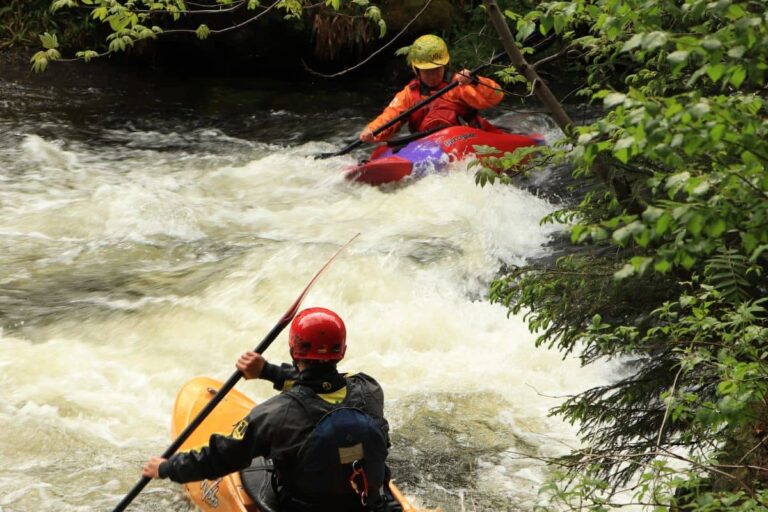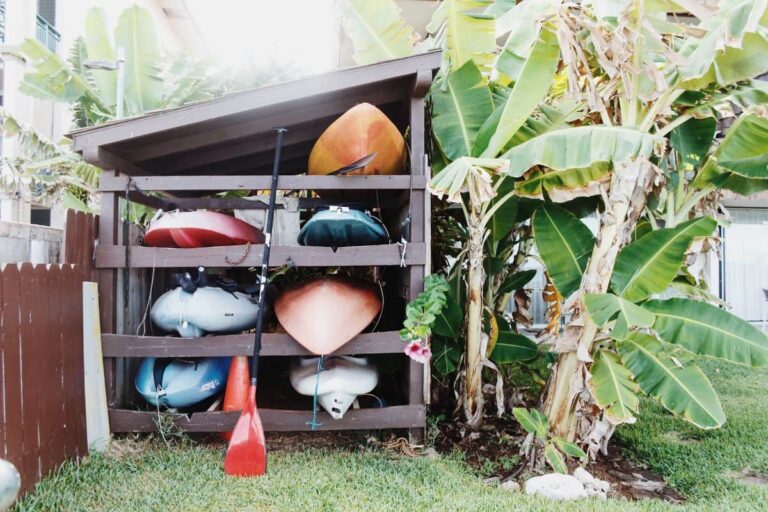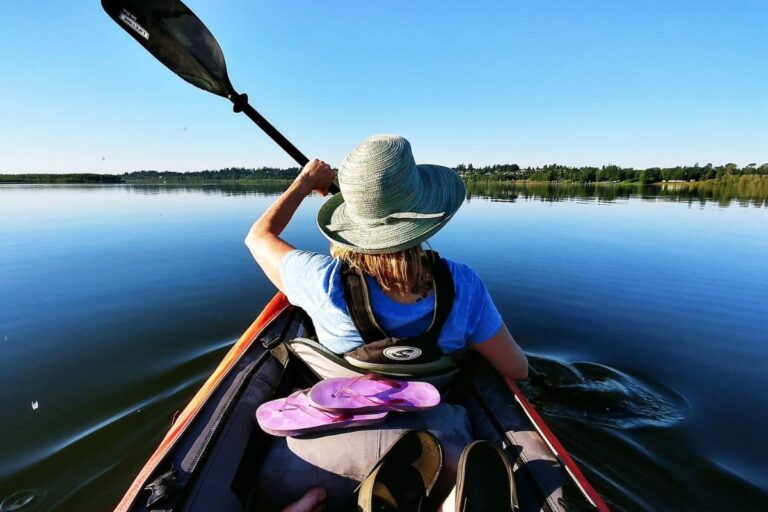How Do You Lock Up A Kayak? (Tried and Tested Methods)
Kayaks are expensive, and unfortunately, kayak theft is common.
Therefore, it’s wise to lock up your kayak to make sure it doesn’t get stolen.
You’ll need a way to lock up your kayak both at home and when you take it out on an adventure!
When you’re outside, locking your kayak up is more complicated than when you’re at home.
To assist you in securing your valuable kayak, we will discuss some tried and tested methods for locking up your kayak.
Both sit-in and sit-on kayaks can be locked safely to various spots. Options for securing your kayak include locking it to your vehicle or trailer, inside or outside your home, and even locking one kayak to another. Keep in mind, inflatable kayaks should not be locked to each other, as they are light and therefore easier to steal.
Why Locking Up Your Kayak Is Important
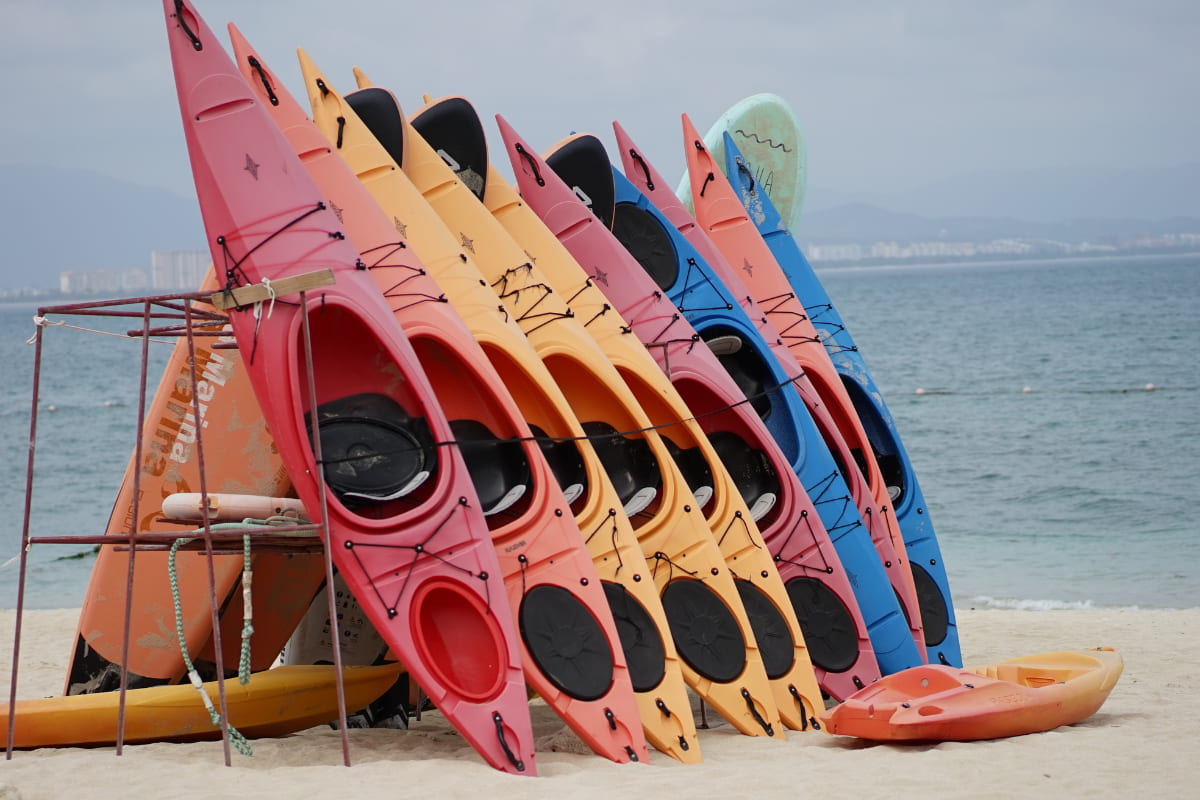
I’ve been kayaking for as long as I can remember, and my current kayak is the third one I’ve owned.
Unfortunately, my first two kayaks were both stolen, so I had to learn the importance of securing your kayak the hard way.
Following these events, I decided to do whatever it takes to keep my kayak secure from now on.
Locking up a kayak isn’t rocket science, and you can secure your boat in different ways.
In this article, we’ll go over each method for how to lock a kayak in great detail.
As a bonus, we’ve also included some pointers on improving your kayak’s general safety.
So keep reading so you can say goodbye to stressing over having your valuable kayak stolen!
1. Secure Your Kayak to Your Car
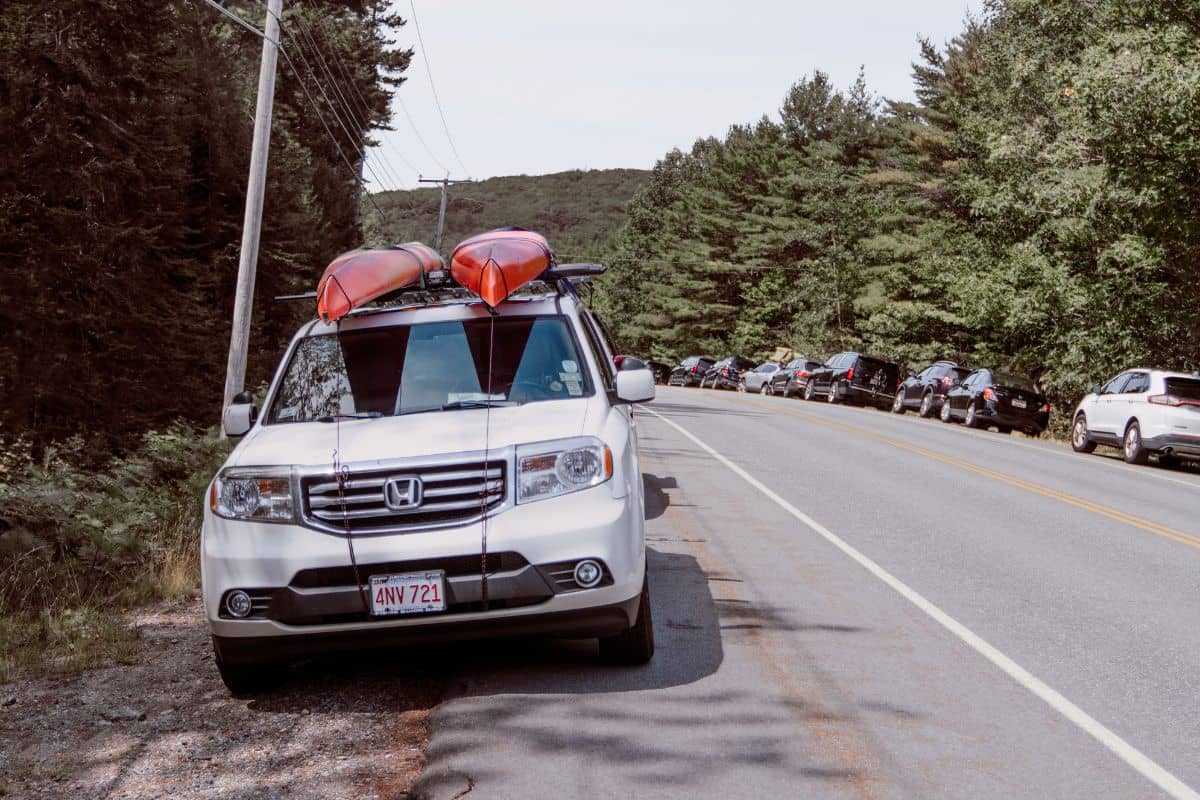
If you leave your kayak unsecured in the back of your vehicle or on a kayak trailer, it will be easy for thieves to get their hands on it.
To prevent this from happening, you need to lock the kayak onto your car’s roof rack or trailer properly.
Tie-downs with a locking system, such as cable locks, work well for this purpose.
You don’t need to go out and buy a fancy lock – a simple bicycle cable lock will do the job.
Most simple locks come with two keys – you may want to leave one key in your vehicle and give the other to a friend, or leave it at home.
This way, you’ll have a backup key in case you lose one!
An easy way to get around the key issue is to just use a combination lock.
If thieves can’t get to your kayak, they may still resort to making a quick buck by attempting to steal your kayaking accessories – that’s why it’s important to keep all of your kayaking accessories locked inside your vehicle.
If these items are too large to fit inside your vehicle, secure them to your car rack using locking straps.
A paddle lock, for example, can be used as a secure locking system for the paddles.
Securing A Sit-On-Top Kayak
For a sit-on-top kayak, you can thread the end of the cable loop through the scupper holes.
Next, pass the cable underneath the roof rack and into the other scupper hole at the kayak’s stern.
Now, join both loops at one end of the cable and lock it up.
Try to eliminate excess cable by wrapping the kayak lock around and through the kayak and roof racks as much as possible.
Securing A Sit-In Kayak
Although sit-in kayaks don’t usually have scupper holes, some are equipped with cable bars.
If yours doesn’t have cable bars, you can use the kayak’s handles instead.
You’ll need a kayak lock with a cable that’s long enough to loop around the bow and stern of the kayak.
Locking a sit-in kayak to an anchor point will require you to place a cable with one end around the bow and the other over the stern.
This way, the cable’s center will wrap around the anchor point.
Ensure that the cable is tight, because if it’s loose it will be easy for someone to untie it or use bolt cutters to break it.
Another option is to drill scupper holes into the kayak yourself.
However, doing this can be tricky since you need to make sure the drain hole will not tamper with the watertight hull and exterior walls of the kayak.
After making your scupper holes, you can follow the same tutorial as those listed above for locking up a sit-on-top kayak.
You can also install two loops onto the deck of the kayak.
These are somewhat common in fishing kayaks, but can be installed in any other kind of boat as well.
Having something through which to loop the cable of your combination lock will go a long way in ensuring that your boat is as theft-proof as possible.
2. Lock Your Kayak at Home
Storing and locking your kayak in your garage is a great way to keep your kayak safe.
A locked shed or other permanent structure secured with a cable lock is also a useful option.
Unfortunately, storing a kayak at home is challenging for many people.
Because of this, some opt for inflatable kayaks that can be deflated and stored easily in small areas.
If you don’t have enough room to keep your hard-shell kayak inside a garage or shed, it will be harder to protect it from thieves.
In such cases, you’ll have to go the extra mile and be creative.
You can create a wall-mounted or freestanding kayak rack for securing your kayak.
Building a DIY kayak rack near your home can offer an additional deterrent for would-be thieves.
You can even adapt a roof rack made for a vehicle by attaching it to a secure object and turning it into a stationary rack for either a sit-on-top or sit-inside kayak.
You can also use the same lockable straps you use to secure your kayak to your roof rack to lock it to your freestanding rack as well.
It’s always a good idea to use an additional cable or two for added protection when storing your kayak for a long period of time.
Installing a motion-sensor light to the area where your kayak rack is located can also be a great deterrent for a potential thief.
The minor extra cost of the light is a small price to pay when you consider how well a light can work for preventing robbery.
The Alternative Way
Now, if the methods above won’t work for you, you can explore options you may already have in your yard.
Most stationary objects will work as an anchoring point to which you can attach and lock your kayak.
For example, a tree can be used as a solid anchoring point.
All you have to do is wrap cable locks around the tree, and then thread them through the plug holes or handles of your kayak.
When using this method, make sure to cover it with a tarp or something similar.
Keeping your boat out of sight is another step to help keep your kayak safe.
3. Lock Your Kayak Outdoors
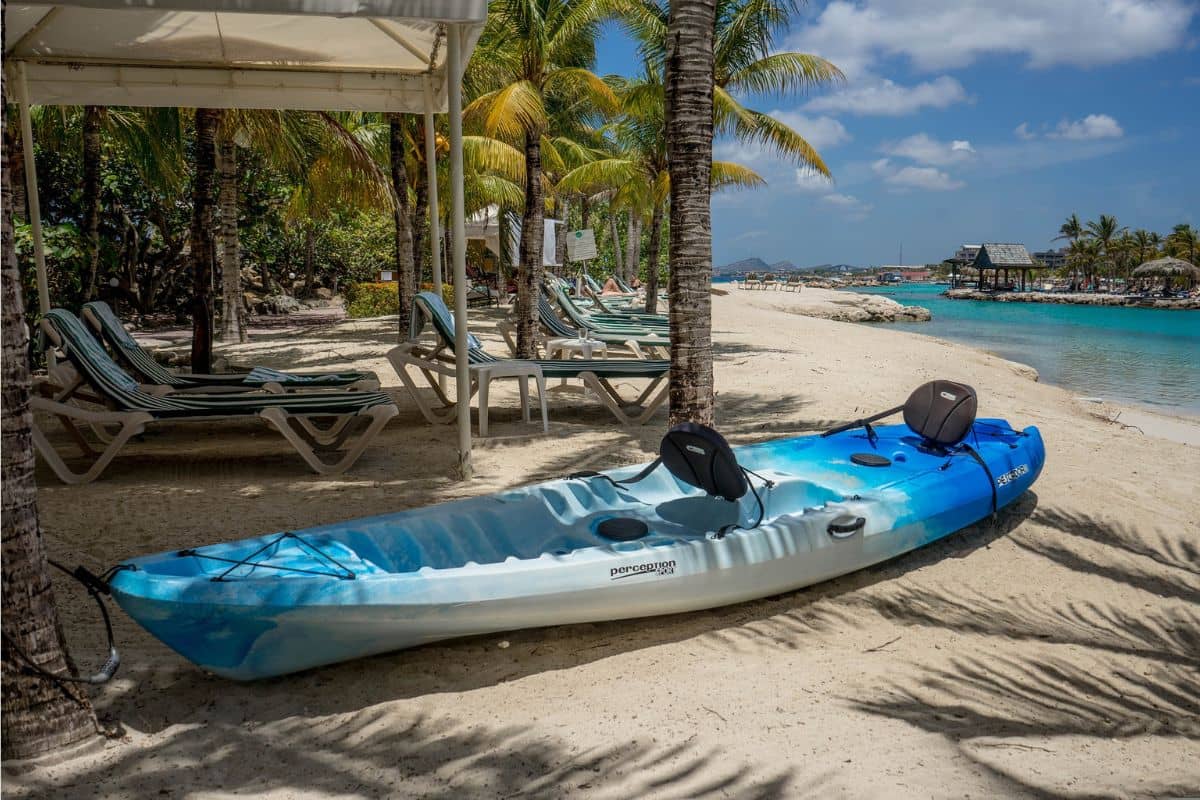
Taking your sit-on-top or sit-inside kayak on a camping trip can be problematic, since you can’t usually store our boat inside your tent!
That might work with an inflatable kayak, but a hard-shell kayak is hard to fit in most places.
One option is to leave your kayak secured to your vehicle roof rack or trailer.
To do this, follow the steps from the tutorial outlined above.
However, when camping, you can also find a tree nearby if you want to keep your boat closer to your tent, and use a cable lock to secure your kayak to the tree.
4. Locking Up An Inflatable Kayak
Inflatable kayaks are in high demand these days due to their portability and convenience.
They’re also easy to lock up and store, which can save you a lot of trouble.
You can just deflate your inflatable kayak and lock it inside your car, house, or tent if you’re on a camping trip.
But if you are frequently on an adventure where you use your kayak often, it may be easier to leave your boat inflated between paddling trips.
So, instead of compressing your kayak between every use, you can use a cable lock to secure it between its paddles.
While transporting an inflatable kayak, you can lock it on the roof rack with the same cable lock method that we mentioned earlier for sit-inside kayaks.
You can purchase the same cable lock for either type of kayak.
When locking your kayak to an anchor point, make sure to choose a solid anchor point and don’t allow too much slack in the cable to prevent it from unwinding.
Note: Do not lock two inflatable kayaks together for security, as they are lightweight and are much easier to pick up and carry away, just making it easier for a determined thief to steal two kayaks instead of one.
5. Lock Sit-On-Top Kayaks Together
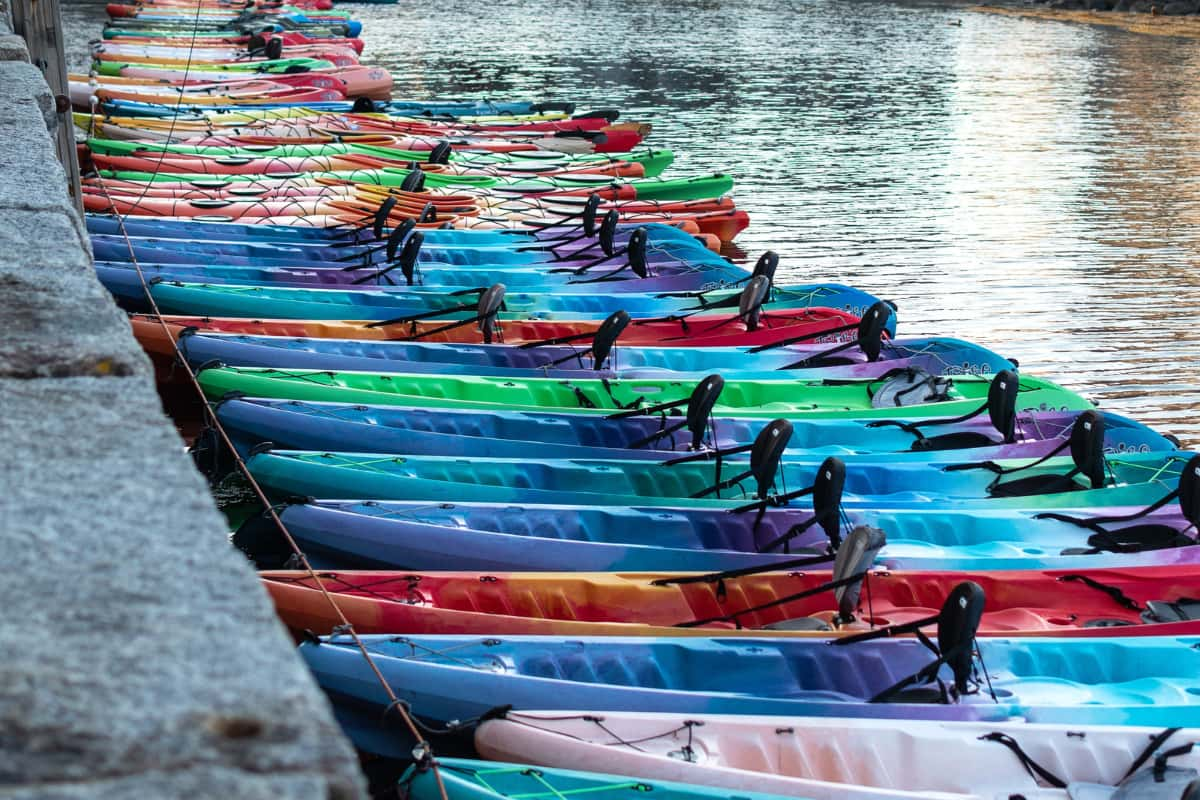
If you can’t find a good anchor point, then you can ask someone to let you lock your kayak to theirs.
You can even secure several sit-on-top kayaks on top of each other, thereby making them too heavy to carry away.
You will have to thread one end of the cable through the scupper plug holes of each kayak before connecting it back to the other end and locking it.
If your cable is long, you can pass it through multiple scupper holes on each kayak before connecting it back to the combination lock.
By locking kayaks this way, you can ensure top-notch security and it will be hard for anyone to untie your boat.
6. Lock Sit-Inside Kayak Together
There might be a slight complication if you have a sit-inside kayak and want to lock it up with another kayak — the reason being that these kayaks don’t have a drain hole through which you can thread your cable.
In this case, you’ll have to pass the cable through a stationary object on the kayak, such as its handles.
There are also tiny metal loops on the floor of the kayak at the stern that you can use to lock two sit-inside kayaks together.
However, you will have to get a cable thinner than the one used for locking the kayak to the anchor point.
First, you’ll need to measure the area under the loops to ensure that your cable lock will fit through the opening.
In addition, if your kayak has bars, you can use a cable wrapped around the bars to allow for more flexibility when fastening sit-inside kayaks together.
Secret Tips For Keeping Your Kayak Safe Besides Locking It
If, even after learning how to lock up a kayak, you’re still anxious that your new kayak might get stolen, don’t worry!
We will now outline three additional ways to protect your kayak, which can even be beneficial for recovering stolen kayaks.
Get Specialist Kayak Insurance
In order to be prepared for unexpected circumstances, you can get insurance for your kayak.
However, if you already have a homeowner’s insurance policy, it will most likely cover your kayak and its accessories.
To make sure, go through the details of your current policy and see whether it provides boat insurance.
Most of these policies only protect boats within a specific price range – if your kayak is over the price limit, you may need to look into separate kayak or watercraft insurance.
Register And Note Down Your Kayak’s HIN
Unless your kayak was manufactured before 1972, every kayak has a Hull Identification Number (or “HIN”), which is a 12-digit code unique to every kayak, usually engraved close to the stern.
If, despite your best efforts, your kayak still gets stolen, this kayak ID could be your savior.
At this time, you’d be able to contact the authorities and give them your hull identification number, and they will do their best to find and return your kayak to you.
Unfortunately nowadays, many thieves have become highly crafty, and they will likely remove the HIN soon after stealing your boat.
So, you can outsmart them by engraving your HIN in a more obscure location such as under the seat, deck, or even in the storage compartment.
Keep Your Kayak Out Of Sight
This tip applies when you’re keeping your kayak at home and want to be extra careful.
If your kayak is just sitting out in the open, someone is more likely to be lured to it.
To keep your kayak out of sight, you can store it in your basement, shed, or garage.
If these are not viable options for you, you need to at least cover your kayak with a tarp after locking it up.
This will make it much harder for anyone to be able to identify what the object is from afar.
Conclusion
To sum up, there are several ways to lock your kayak, whether you have a sit-on-top or sit-inside kayak.
Generally, hard-shell kayaks tend to be a bit tricky to lock or store.
However, using the multiple methods listed above, you now have plenty of options for securing your kayak confidently.
Even though inflatable kayaks are much easier to lock and store, remember that the option of locking two kayaks together does not work with inflatable models.
Table of Contents

